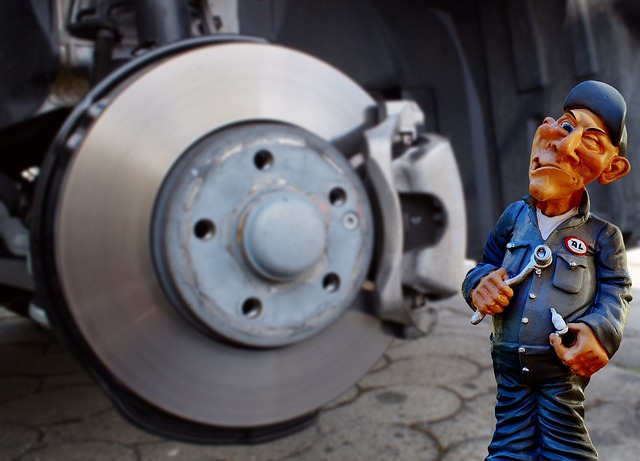Panel Beating: Unlocking Efficient Collision Repair Techniques
Panel beating is a specialized collision repair art that combines technical expertise, creativity, a…….
In the realm of manufacturing, construction, and design, panel beating stands as an art and science that transforms raw materials into intricate, structural components. This ancient technique, with roots tracing back centuries, has evolved into a modern, precision-driven industry vital to various sectors. From building robust frames for automobiles to crafting elegant facades for skyscrapers, panel beating plays a discreet yet pivotal role in shaping our world.
This article aims to provide an all-encompassing guide to panel beating, exploring its history, techniques, global impact, and future prospects. By delving into each aspect, we will uncover the significance of this trade, its influence on modern infrastructure, and the challenges it faces in a rapidly changing landscape.
Definition: Panel beating is a specialized metalworking process that involves shaping, forming, and joining sheet metal to create rigid panels or components. This art requires skilled labor and precise techniques to ensure the final product meets structural integrity, aesthetic appeal, and dimensional accuracy.
Core Components: The essence of panel beating lies in its three primary stages:
Preparation: This initial step involves selecting the appropriate gauge and type of metal, cutting it to desired sizes, and preparing it for forming. Skilled panellers (metalworkers) ensure the metal is free from defects and properly aligned for subsequent operations.
Forming: Here, the metal is manipulated using specialized tools and machinery to achieve the required shape. Techniques include hammering, rolling, pressing, and folding, each method imparting unique characteristics to the final panel. Panellers must possess a deep understanding of material behavior to avoid distortions or weaknesses.
Joining: Depending on the application, panels are joined using various methods such as welding, riveting, bolting, or adhesion. Skilled craftsmen select the most suitable joining technique based on factors like structural integrity, load-bearing capacity, and aesthetic considerations.
Historical Context: The history of panel beating is deeply intertwined with human progress and innovation. Ancient civilizations like the Egyptians and Greeks utilized basic metalworking techniques, but it was during the Industrial Revolution that panel beating evolved into a sophisticated craft. With the rise of manufacturing and construction industries, demand for stronger, lighter, and more aesthetically pleasing components grew, driving advancements in panel beating techniques.
Panel beating has transcended geographical boundaries, leaving its mark on diverse regions worldwide. Its influence can be observed across various sectors, from automotive and aerospace to architecture and marine engineering.
Europe: Known for its rich manufacturing heritage, European countries like Germany and the UK have long been at the forefront of panel beating innovations. They are renowned for their precision-engineered components used in high-performance vehicles and advanced aviation structures.
North America: The United States and Canada have a thriving panel beating industry, particularly in automotive and construction sectors. American companies lead in developing lightweight panels for fuel-efficient vehicles, while Canadian firms excel in crafting complex metal facades for modern skyscrapers.
Asia Pacific: This region is witnessing rapid growth in panel beating, driven by the surge in infrastructure development and manufacturing hubs. China and India, in particular, are expanding their capabilities in this field, catering to both domestic needs and global exports.
Middle East and Africa: The MEA region’s construction boom has spurred a demand for advanced metal fabrication, including panel beating techniques. Countries like the UAE and Saudi Arabia are investing heavily in infrastructure development, driving the need for skilled panellers and cutting-edge technology.
Lightweighting: A prominent trend across industries is the push for lightweight components to enhance efficiency and performance. Panel beating is playing a crucial role in achieving this by developing thin yet robust panels, reducing material waste, and improving overall structural integrity.
3D Printing Integration: The advent of 3D printing technology has opened new possibilities for panel beating. Skilled panellers are now incorporating additive manufacturing techniques to create intricate designs and complex geometries, pushing the boundaries of what is achievable through traditional methods.
Sustainability Focus: Environmental concerns have prompted industries to adopt more sustainable practices. Panel beating companies are responding by exploring eco-friendly materials, implementing recycling programs, and developing processes that minimize waste and energy consumption.
The panel beating industry is a significant contributor to global economies, with its impact extending beyond the immediate manufacturing sector.
Global Market Size: According to a recent report by ResearchAndMarkets, the global metal fabricating market, encompassing panel beating, is projected to reach USD 452.7 billion by 2026, growing at a CAGR of 5.8% during the forecast period (2021-2026). This growth is driven by factors like rising infrastructure spending and the need for lightweight, advanced components.
Regional Market Analysis: Asia Pacific dominates the market, followed by North America and Europe. The APAC region’s rapid industrialization and infrastructure development are major drivers, while North American markets benefit from robust automotive and aerospace sectors.
Industry Players: Major global companies like ArcelorMittal (Europe), US Steel (North America), and JSW Steel (Asia Pacific) are key players in the panel beating sector. These corporations invest heavily in research and development, advanced machinery, and skilled labor to maintain a competitive edge.
Startup Innovations: The industry also nurtures a thriving ecosystem of startups focusing on specialized panel beating techniques and innovative materials. These new entrants bring fresh ideas, pushing the boundaries of what is possible within the field.
Job Creation: Panel beating and related metalworking industries contribute significantly to employment, offering skilled tradespeople well-paid, secure jobs. According to the International Labour Organization, the manufacturing sector globally employs over 17% of the total labor force (2021 data).
Supply Chain Interlinkages: The industry’s ripple effect through supply chains is substantial. From raw material suppliers to finishing and assembly plants, panel beating companies form intricate networks, fostering economic growth and regional development.
Technology has revolutionized panel beating, enabling more efficient, precise, and diverse applications.
Computer Numerical Control (CNC) Machinery: CNC machines have transformed panel beating by automating the forming process. These sophisticated tools use computer-controlled movements to shape metal with unprecedented accuracy, reducing human error and improving productivity.
Laser Cutting and Welding: Laser technology has enhanced precision in cutting and welding operations. High-powered lasers can cut through various materials quickly, ensuring clean, accurate cuts. Similarly, laser welding offers a precise, efficient method for joining panels, minimizing heat input and distortion.
Advanced Materials: The development of new alloy compositions and composite materials has expanded the possibilities for panel beating. These innovative materials offer improved strength-to-weight ratios, enhanced corrosion resistance, and unique aesthetic properties, catering to diverse industry needs.
Technological advancements have enabled panel beating to cross into uncharted territories:
Complex Geometries: CNC machinery and 3D printing allow for the creation of intricate metal components with complex geometries that were once unimaginable. This opens doors for innovative design in architecture, automotive, and aerospace.
Customized Components: Digital technologies facilitate personalized manufacturing, enabling panellers to create customized, one-off panels tailored to specific client requirements.
Rapid Prototyping: Advanced machinery and materials now allow for faster prototyping, accelerating product development cycles across industries. This speed is critical in today’s fast-paced market, where time-to-market is a key competitive advantage.
The panel beating industry operates within a framework of policies and regulations that ensure safety, environmental sustainability, and fair competition.
Occupational Safety and Health: Many countries have stringent regulations to protect workers in metal fabrication industries, including panel beating. These include guidelines for safe handling of machinery, control of hazardous substances, and personal protective equipment (PPE) usage.
Environmental Standards: Environmental protection is a global priority, leading to regulations governing waste management, emissions control, and energy efficiency in manufacturing processes. Panel beating companies must adhere to these standards to minimize their ecological footprint.
Trade Policies: International trade agreements influence the panel beating industry, particularly regarding import/export tariffs, customs procedures, and market access. These policies can significantly impact global supply chains and regional economic development.
Policies and regulations play a pivotal role in shaping the industry’s trajectory:
Safety Standards: Strict safety protocols ensure that panel beating remains a viable, attractive career choice for skilled workers. They also contribute to improving workplace conditions, reducing accidents, and enhancing overall productivity.
Environmental Compliance: The industry’s commitment to sustainability is driven by regulatory requirements, fostering the development of eco-friendly practices and technologies.
Fair Competition: Regulatory frameworks promote fair trade practices, protecting consumers and ensuring that panel beating services are provided at competitive prices without compromising quality.
Despite its numerous advantages, the panel beating industry faces several challenges and criticisms that require careful consideration and strategic responses.
Skilled Labor Shortage: The demand for skilled panellers often exceeds supply, leading to labor shortages in many regions. This gap can be attributed to aging workforces, perceived low pay, and the perception of manual labor as less desirable. Addressing this requires investment in training programs and improving industry reputation.
Material Cost Volatility: Panel beating relies on raw materials, and their prices are subject to market fluctuations. Volatile metal prices can impact profitability and project timelines, especially for long-term infrastructure projects. Diversifying material sources and developing cost-effective alternatives are potential solutions.
Environmental Concerns: While the industry is making strides towards sustainability, environmental criticism persists. Issues like waste management, energy consumption, and carbon emissions remain areas of focus, requiring continuous innovation and implementation of green practices.
Criticisms often highlight the industry’s potential negative impacts:
Air Pollution: Metal fabrication processes can contribute to air pollution, particularly in regions with lax environmental regulations. Implementing cleaner technologies and adhering to strict emission standards are essential to mitigate this.
Noise and Vibration: Machine operations in panel beating workshops can generate significant noise and vibration levels, affecting nearby communities. Proper noise control measures and adherence to local regulations can address these concerns.
Waste Generation: The industry’s historical reliance on traditional, waste-intensive processes has drawn criticism. Adopting more sustainable practices, recycling programs, and exploring circular economy models are strategies to reduce waste and promote resource efficiency.
A leading European manufacturer of high-speed trains collaborated with panel beating specialists to develop lightweight, yet robust passenger cars. By utilizing advanced CNC machinery and precision welding techniques, they crafted intricate metal panels that reduced overall vehicle weight by 20%. This achievement not only enhanced fuel efficiency but also improved the train’s overall performance and passenger comfort. The project highlighted the industry’s ability to meet stringent design requirements while maintaining structural integrity.
A major North American construction firm partnered with panel beating experts to craft eco-friendly facades for a landmark skyscraper. Using recycled materials and innovative laser cutting techniques, they produced intricate metal panels with minimal waste. These panels not only enhanced the building’s aesthetic appeal but also provided excellent insulation, reducing energy consumption significantly. This case study demonstrates the industry’s potential to contribute to sustainable construction practices.
A Japanese automotive giant implemented a digitalized panel beating process to streamline production of complex vehicle body panels. By integrating CNC machines and 3D printing, they achieved unprecedented precision and faster turnaround times. This resulted in reduced assembly time, lower manufacturing costs, and improved overall vehicle quality. The project emphasized the industry’s role in driving innovation and efficiency within the automotive sector.
The panel beating industry stands at a crossroads, with several emerging trends shaping its future trajectory.
Renewable Energy Infrastructure: With the global push for renewable energy sources, there will be increased demand for panel beating services in manufacturing solar panels, wind turbines, and related components. This presents a significant growth opportunity, particularly for companies specializing in lightweight, durable metal structures.
Advanced Aerospace Components: The aerospace industry is undergoing a revolution with the development of more efficient, lighter aircraft. Panel beating will play a crucial role in crafting intricate metal components for these aircraft, including engine parts and fuel systems.
Smart Cities and Infrastructure: The concept of smart cities, coupled with infrastructure development projects worldwide, will drive demand for advanced metal structures. Panel beating companies can contribute by providing customized, high-performance panels for intelligent transportation systems, energy-efficient buildings, and futuristic public spaces.
Digital Twin Technology: The integration of digital twin technology in panel beating processes allows for virtual prototyping and testing, reducing time and costs associated with physical development. This trend will enable faster iteration cycles and more sophisticated designs.
Additive Manufacturing Growth: While 3D printing is not a replacement for traditional panel beating, it complements the process by enabling the creation of complex geometries and on-demand production. Companies adopting this technology early may gain a competitive edge.
To thrive in the future, panel beating businesses should:
Invest in Technology: Continuous investment in advanced machinery, digital tools, and materials research is essential to stay ahead of industry trends and maintain a competitive advantage.
Embrace Sustainability: Incorporating eco-friendly practices, exploring circular economy models, and developing sustainable materials will be crucial for meeting environmental expectations and securing long-term growth.
Foster Skilled Workforce: Addressing the skilled labor shortage requires investment in training programs, apprenticeships, and industry marketing to attract and retain top talent.
Global Collaboration: Expanding global reach through partnerships and collaborations can provide access to new markets, diverse talent pools, and innovative ideas, fostering continuous improvement.
Panel beating, an ancient craft woven into the fabric of modern society, continues to evolve and adapt to changing demands. Its global impact is profound, shaping infrastructure, transportation, and energy solutions that propel our world forward. From lightweight automotive components to advanced aerospace structures, panel beating plays a pivotal role in defining our future.
By embracing technological advancements, addressing industry challenges, and adopting sustainable practices, the panel beating industry can unlock unprecedented opportunities. The path ahead involves continuous innovation, strategic partnerships, and a commitment to skill development. As we navigate an increasingly complex global landscape, the contributions of panel beating professionals will be indispensable in building a brighter, more sustainable future.

Panel beating is a specialized collision repair art that combines technical expertise, creativity, a…….

Panel beating, an ancient craft vital to automotive restoration, involves shaping metal sheets for p…….

Panel beating, an ancient yet modern auto body repair technique, excels in precision and sustainabil…….

Panel beating, an art and science of auto body repair, restores damaged metal panels on vehicles fro…….

Panel beating is a specialized automotive craft focusing on restoring damaged car bodies to pre-inci…….

Understanding panel beating timelines is key for both repair shops and consumers. Minor dent repairs…….